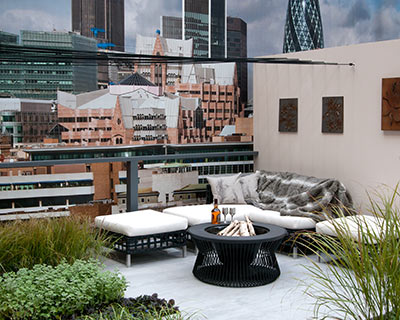Greening balconies and roof gardens
Gardens where they’re most precious of all – in the heart of towns and cities
Things to check before you start
- Is it structurally possible? Roof gardens are entirely dependent on the strength of the roof beneath them, and balconies will only be able to take a certain weight. If you’re not sure, ask a chartered structural engineer or a surveyor to confirm what is possible.
- Is it legal? You may need planning permission for a roof garden, especially if there’s not a perimeter wall or handrail and you need to install one – the minimum height for handrails in the UK is 1.1m.
- Is there a water supply? Is there an outdoor tap: if not, can you install one? Or can you install water butts connected to downpipes? If the answer is no, a green roof is a better option than a roof garden.
Keeping weight down
There are many strategies to reduce the weight of your garden. Try fibreglass, plastic or lightweight metal containers – these also have the advantage of being non-porous so the soil inside them won’t dry out as fast as in terracotta pots. Add polystyrene in the bottom of pots to aid drainage and reduce weight compared to the traditional crocs. Be aware that different composts weigh different amounts: soil (loam)-based composts like John Innes No.3 are good for long-term plantings, and they don’t dry out as quickly as soilless (multipurpose, peat-substitute) ones, but they are heavier.
One way of getting around weight issues is to install a ‘false floor’ such as decking which is partly or completely suspended above the existing roof, directing weight onto surrounding walls. Or you can place any heavy containers near load-bearing walls or over a load-bearing beam or joist as these can take more weight than unsupported areas.
Working with the wind
Being high up can give you wonderful views but it can also make roof gardens and balconies vulnerable to strong winds. If you can, install slatted or mesh screens – they’ll filter the wind and slow it down rather than creating turbulence like solid screens can.
Make sure that pots or containers on exposed rooftops have a low centre of gravity to stop them being blown over – long, low planters work especially well. Taller plants like trees, topiary and climbers will need fixing securely to buildings or rails. Make the most of any sheltered spots for a table and chairs.Plants
To thrive on a roof or balcony, plants ideally need to be both drought and wind tolerant – and luckily there are lots to choose from.
Dense, hardy evergreens such as Viburnum tinus and junipers can create shelter, and phormiums and cordylines create year-round structural interest.
Wildlife
A surprising amount of wildlife can make a home on roof gardens and balconies. Bees and other pollinating insects, as well as birds will delight in these urban sanctuaries just as much as people.
There are many pollinator-friendly flowers such as sedums and lavenders that thrive here. Another benefit of being up high is that there will be fewer pests such as slugs and snails, and definitely no rabbits!
Watering
Life in the sky can be a tough call for plants, far from their natural place in the soil below. To grow a roof garden (rather than a green roof) you’ll need a water supply – ideally an outside tap or at least one water butt. Many different designs of butts are available to suit any space, taste and budget. In warm, windy weather plants may need watering once, if not twice a day – the ideal solution, especially for larger roof gardens, is to install an automatic irrigation system.
With some careful planning and plant selection, you can have an urban oasis that’s easy to care for, colourful and great for both people and wildlife too.


